
The History of the Nansemond Indian Tribal Association
Posted on August 15, 2017 By Nikki Bass

The 29th Annual Nansemond Pow Wow is just a few days away and, though most Nansemond research is focused on the 1600s through the 1800s, I thought this would be a great time to share some insight on recent Nansemond history and the people, both inside and outside the community, who have been influential in the formation of the Nansemond Indian Tribal Association (NITA). This article will include detail on Nansemond leaders, their lineage, state recognition, the establishment of tribal by-laws and enrollment processes, the reclamation of ancestral land, and potential federal recognition.
Nansemond Chiefs
There is a small group of individuals who have held the title of Nansemond chief over the past century. Their contributions to the development of the present day NITA have varied greatly, with some being more focused on the outdoors and survivalism and others being more focused on cultural and political advocacy. In order to highlight these contributions, I have given a name to each chief that reflects who they were and what they valued.
THE PATRIARCH: Chief Jesse Lindsay Bass
(March 22, 1875 – April 28, 1960)
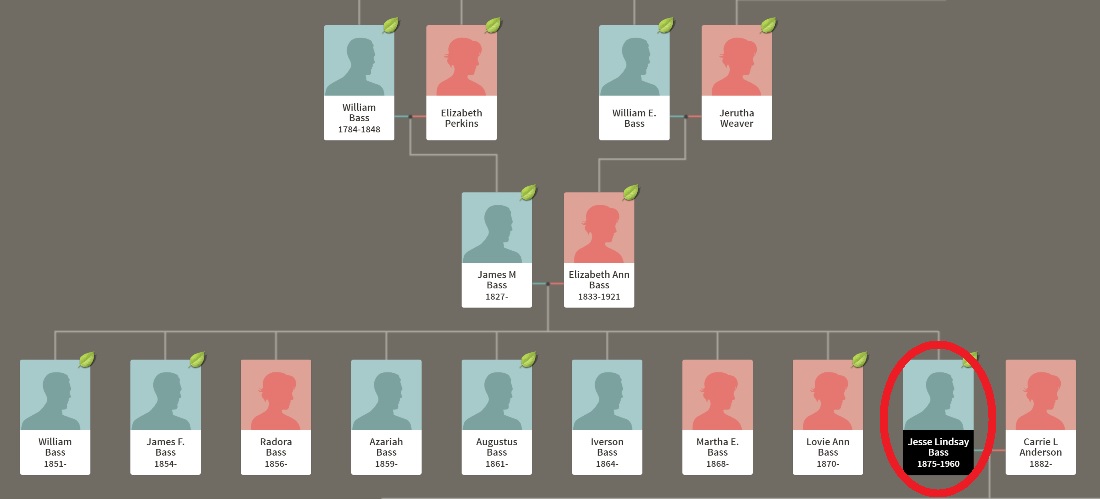
Jesse Lindsay Bass was the youngest son of James Michael Bass and Elizabeth Ann Bass. He was raised in “Yadkin” on the northeastern edge of the Great Dismal Swamp where the Christianized Nansemond community lived for generations before him. He and his family attended Indiana United Methodist Church which was established in 1850 as a mission for the Nansemond families in the area. Jesse worked as a truck farmer, like many others in his community, and married Clara (Carrie) Lugene Anderson in 1899. He and Carrie had twelve children over the course of their lives and raised them on Galberry Road in Norfolk County, VA.

Due to his love and natural talent as a hunter, Jesse was known as the “Daniel Boone of Norfolk County.” He attributed this ability to his grandfather, William Bass, and passed the passion on to his own sons. Jesse’s favorite place to hunt was in the Great Dismal Swamp (where he was noted as trapping in Washington Ditch on the west side of Lake Drummond) and he was a member of the Yadkin Hunt Club.
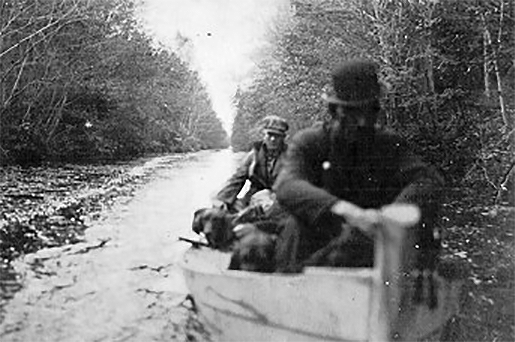
Records reveal that Jesse and his family consistently identified as “Indian” and lived as part of an insular Indian community (with several marriages between cousins). During Jesse’s lifetime a number of anthropologists, most notably James Mooney and Frank Speck, researched Powhatan tribes throughout Virginia and had several visits with the Nansemond in the area. Despite their encouragement to organize and pursue state recognition for the tribe, Jesse had little interest in the bureaucracy and political action required for such an effort.
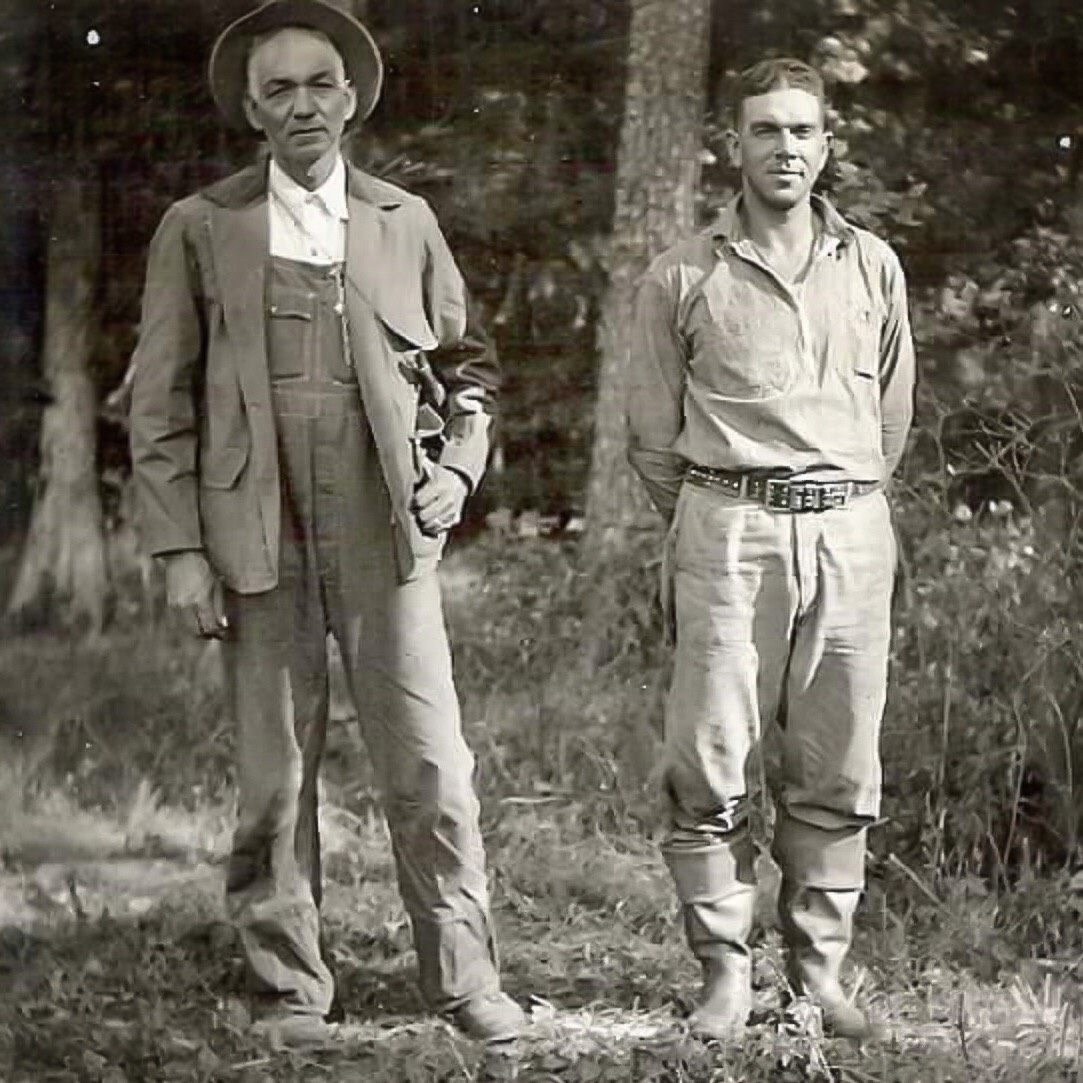
Jesse’s legacy with the Nansemond community is his legendary familiarity with the Great Dismal Swamp and his ability to survive from the land like his Nansemond ancestors. He and several of his contemporaries (e.g., his older brother Augustus A. Bass) opened their lives to anthropological research that led to the publication of several important references for future generations. Jesse Lindsay Bass’ name remains one of the most recognized among Nansemond descendants and researchers.

THE OUTDOORSMAN: Chief Earl Lawrence Bass
(August 27, 1909 – October 12, 1996)

Earl Lawrence Bass was the son of Jesse L. Bass and Carrie L. Anderson. He married Lucille Bass (the daughter of William Henry Bass and Victoria Sculthorpe) in Camden County, NC on November 8, 1927. Earl and Lucille raised their children on Jolliff Road in Norfolk County, VA on the northwestern edge of the Yadkin Nansemond community. Like his father, Earl was a member of Yadkin Hunt Club and he was known for keeping 30-60 hunting dogs at a time. He too was a guide for prominent professionals of the region into the swamp on paid hunting excursions and was featured in statewide magazines for his expertise.
Earl lived through a number of societal changes. The Racial Integrity Act, which passed the Virginia General Assembly on March 20, 1924, required that all Virginians be divided into two races at birth—”White” or “Negro.” This meant that members of the Nansemond community who were documented as “Indian” for generations would be forced into one of these categories. Walter Plecker, who was Virginia’s Registrar of Statistics from the 1920s through the 1940s, specifically targeted the Basses of Norfolk County (as well as the Sawyers, Weavers, Locklears, Kings, Brights, Porters, and Ingrams) for “passing” as Indian and retroactively changed a number of birth records to comply with this new piece of legislation.
Earl also lived through the Civil Rights Movement of the 1950s and 1960s and the political resurgence of tidewater Native Americans in the 1980s. Like his father, Earl Bass’ legacy was that of a hunter with an innate connection to the land, water, and wildlife. His legacy is also that of a transitional figure—his generation being the bridge between the unorganized, extended family of Nansemond descendants and the ultimate formation of the NITA.
THE ORGANIZER: Chief Oliver “Fish Hawk” Linwood Perry, Sr.
(October 7, 1922 – October 2, 2010)
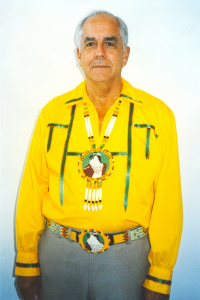
Oliver Linwood Perry was born the son of Richard L. Perry, Sr. and Fannie Bond Perry (a fourth cousin once removed of Earl L. Bass). Unlike Jesse and Earl, he grew up on 32nd Street in Norfolk City about 20 minutes northeast of Bowers Hill. While many of the Nansemond men of the Yadkin area were truck farmers, Oliver had a long career in the United States military (as both a service member and civilian).
In the early days of his retirement, Oliver was inspired to learn more about his Indian ancestry by the organization of a number of Virginia Indian tribes in the 1980s. An Indian state council formed in 1982 with tribal representatives from the Mattaponi, Rappahannock, and Chickahominy (but the Nansemond were not represented because Earl Bass had not become involved). This created an opportunity for Oliver to engage as an organizer for the unorganized Nansemond descendants (many of which did not even know what type of Indian they descended from).
Oliver dedicated himself to the research and documentation of his Indian ancestors. After about a year, when he had a body of information to share (collected from local courthouses and libraries), he held the first meeting of Nansemond descendants on July 21, 1984. Oliver expected a small gathering of about twenty people but a surprising sixty-one people attended and strongly supported the goal to formally organize the tribe. Through a concentrated effort involving several other Virginia Indian tribes, anthropologists, and state officials, the Nansemond were granted state recognition on February 20, 1985 under House Joint Resolution No. 205.
The records submitted through the state recognition process are available at the Library of Virginia in Governor Chuck Robb’s (1982-1986) Papers (Accession # 32462). One might assume this record collection would contain a complete Nansemond genealogy but it does not. The recognition process was more focused on validating the continuous existence of a tribal community than on presenting a broad and complete tribal genealogy.
The most informative document in the set is a paper by Helen Rountree titled “The Ethnogenesis of a Virginia Indian Tribe: The Nansemond Indian Tribal Association.” In it, Rountree provided a candid account of her support to the Nansemond through the challenging process of forming of a tribal association after decades of living as an insular yet assimilated community of extended family. Her narrative includes everything from the earliest efforts to organize, to meetings with more mature tribal associations, the establishment of by-laws and enrollment processes, meeting format, and the re-creation of historically accurate Nansemond traditions.
These accomplishments made Oliver Perry one of the most influential people in modern Nansemond history. In his lifetime, he was appointed by the Governor to the Virginia Council on Indians from 1986 to 1995 (chaired by Thomasina E. Jordan, the namesake of the bill for the Federal Recognition of Virginia Indian tribes), a representative of the Commonwealth of Virginia to the National Governors’ Interstate Indian Council Conference from 1986 to 1995, and an educator at a number of regional events on Indian history.
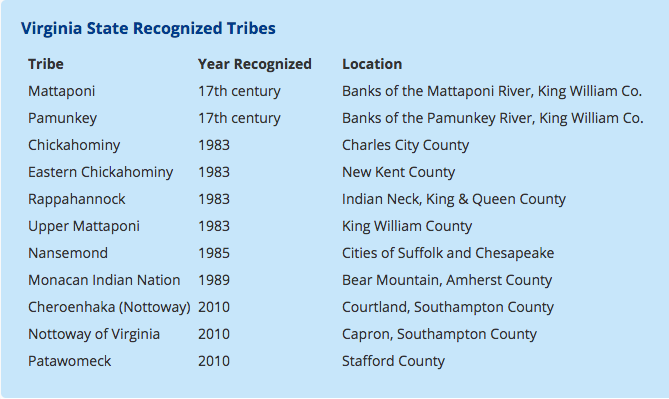
Oliver Perry’s legacy, which is unstudied by many due to his lack of the recognizable Bass name, is that of a strong organizer and communicator in recent Nansemond history. Beyond leading the tribe to state recognition, he established a historical and genealogical foundation for the tribe to grow.
THE RESTORER: Chief Barry “Big Buck” Bass
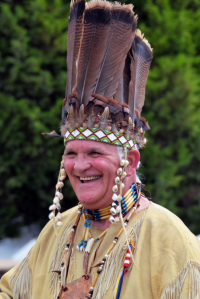
Barry Bass is the son of Joseph Alwood Bass (son of Earl Lawrence Bass) and Lucille Wyant who married in Pasquotank County, NC on January 13, 1950. He was elected as chief in 2008 (just two years prior to the passing of Oliver Perry). Under Chief Barry Bass’ leadership, the Nansemond tribe has seen significant advancements. After ten years of negotiations, the City of Suffolk agreed to return roughly 77 acres of ancestral land in Lone Star Lakes Park (facing the Nansemond River) to the tribe in 2013. This milestone, as the first Nansemond-owned land since the sale of the tribe’s last land in 1792, was celebrated at the 26th Annual Nansemond Pow Wow.
As part of an agreement with the city, the NITA developed plans for a 17th century replica village called Mattanock Town (named after one of the original four Nansemond villages mentioned in the writing of Captain John Smith). Development plans for Mattanock Town include a burial ground, cultural center, and a number of attractions for an estimated 50,000 paying visitors each year. This monumental vision will require a significant amount of private funding to come to fruition but progress has been steady through support from the community.

From initial state recognition in 1985 to today, the NITA has grown to approximately 200 tribal members. In more recent years, Chief Barry Bass has been seen less and (former Assistant) Chief Earl Bass has assumed leadership at tribal events and meetings (with his brother Samuel Bass in the role of Assistant Chief). Chief Barry Bass leaves a legacy as a respected leader during a period of Nansemond growth and revitalization and Chief Earl Bass has been an open and accessible leader in his time at the forefront.

As is evident from the history of Nansemond chiefs, tribal leadership has primarily come from the direct descendants of Jesse Lindsay Bass. Oliver Perry (a Bass cousin) rose to leadership through strong advocacy and political action on behalf of the tribe. Today, leadership has returned to the Bass line and a number of new opportunities wait on the horizon—most notably the 2017-2018 re-introduction of the Thomasina E. Jordan Bill for the Federal Recognition of 6 state-recognized Virginia Indian tribes.
Nansemond-Descended Historians & Genealogists
In addition to official tribal leadership, a number of individuals of Nansemond ancestry have researched and published tribal history and genealogy. These people have both directly and indirectly influenced the growth of the tribe by determining the lineage(s) accepted for tribal enrollment. While the history of Nansemond people as a whole is well documented, Nansemond genealogy has been complex and controversial. The integration of genetic data (and the patrilineal Y-DNA of Bass descendants) into the establishment of Nansemond lineage has been a recent source of contention among descendants and researchers.
Leland (Lea) Lewis Dowd
Lea Dowd is a Nansemond tribal member and refers to her ancestors as part of the Nansemond community that was not Christianized. While her direct ancestors are not publicly documented, she may have been referencing the Nansemond people who lived as part of the Nottoway community of Southampton County, VA after being displaced by colonists.
Among Nansemond researchers, Lea Dowd is recognized as the primary tribal genealogist of the 1990s through the 2000s. While she is noted as having researched the Nansemond for decades, her findings are not highly accessible. She published an article in the North Carolina Genealogical Society Journal (February 1996) titled “Conflicting Information on Basse/Bass Heritage” in which she strongly disputed some of the research of Paul Heinegg and some of the research of Albert Dehner Bell. She, along with fellow Nansemond researcher Patti L. Silvestri, also published an article titled “Descendants of Edward Basse and Mary Tucker: Another Native American Family“ in which they proposed that Edward Bass was part of another tribal community.
In addition to her published research, Lea has an inactive personal website and she is also the registrant (and likely webmaster) of the Nansemond.org web address. Many Nansemond descendants and genealogists have corresponded with Lea but in recent years she has been less accessible. Her reputation is complex as most researchers respect her dedication and experience yet disagree with a number of her published positions. Lea lives in Georgia and, while she has traveled to the Great Dismal Swamp for tribal research, she has not been a part of the close Nansemond community in Norfolk County, VA.
Fred Bright
Fred Bright is a Nansemond tribal member and a Bass through his third great grandmother Elizabeth Bass (wife of Joseph Bright). Joseph Bright was born in North Carolina (possibly part of the large Bright/Brite family of neighboring Camden County, NC) while Elizabeth Bass was part of the Norfolk County Nansemond community. Together they provided the land used to build the Indiana United Methodist Church in Bowers Hill. The same land was used for the Nansemond Indian Public School which was first established in 1890. Fred enrolled in the Nansemond tribe in 1996 and he was already active in Nansemond research by that time. He recorded primary accounts from his Bright and Bass ancestors and was a Family History Director at his local Mormon church.
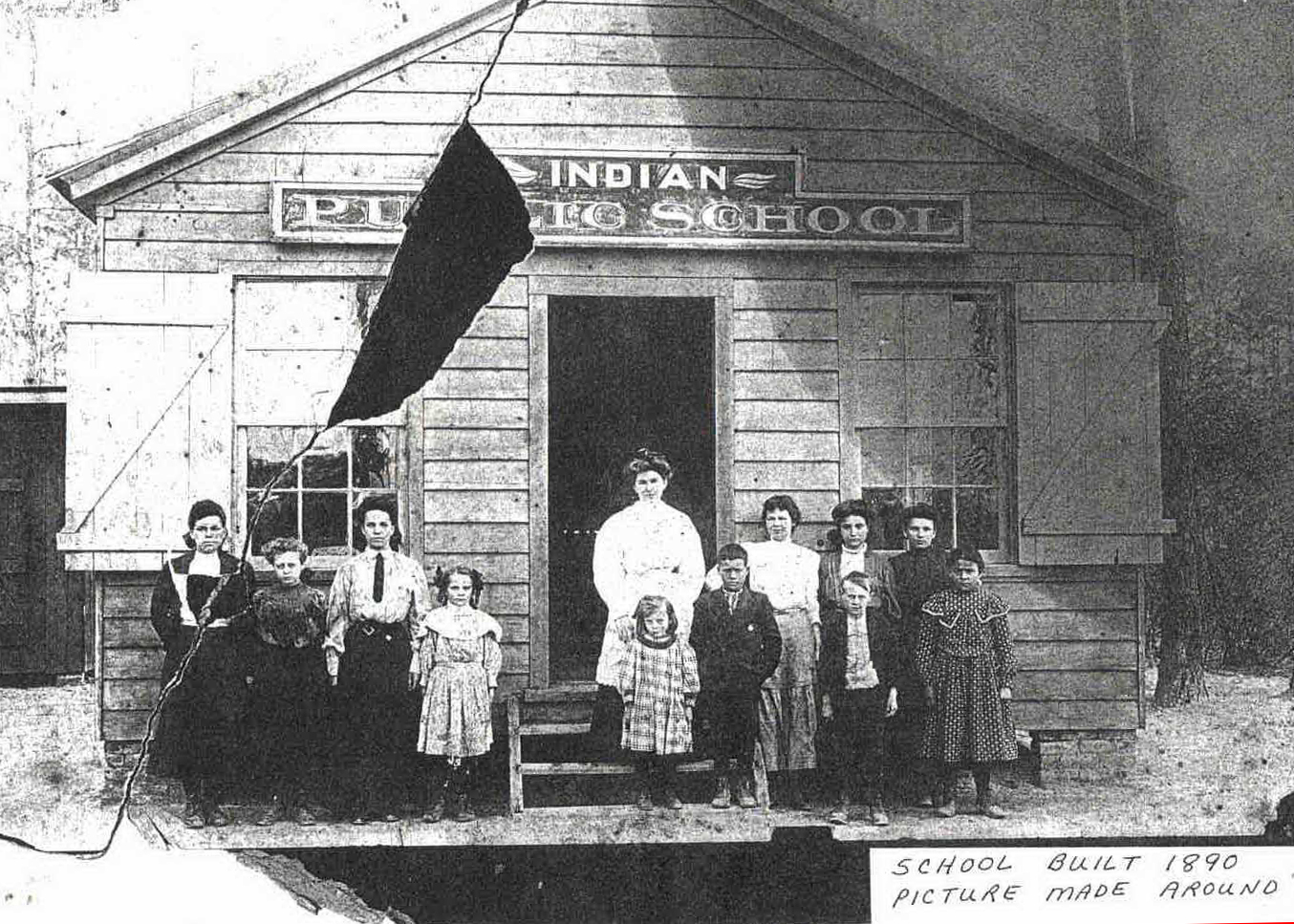
Fred eventually assumed the role of tribal genealogist and partnered in research with Lea Dowd, Patti Silvestri, and Sheila Stover. Like Lea Dowd, Fred has fielded a number of questions from people in the online research community; however, he has not published articles on the subject. As a member of the Norfolk County Nansemond community, he has dedicated most of his effort to cultural and environmental preservation by teaching lessons on flint knapping to craft arrowheads and serving on the Crittenden Eclipse Heritage Foundation’s project to map the Nansemond River. Fred has been a familiar face at many of the Nansemond Pow Wows and participated in a number of programs.
Influential Researchers
In addition to Nansemond-descended researchers, there have been a number of individuals without Nansemond ancestry who have researched and published tribal history and genealogy. There are many researchers who could be included in this section (most notably Paul Heinegg who has published one of the broadest and most widely referenced Bass lineages) but this list is limited to those who have received authorized access to tribal records and collected primary accounts from tribal leadership.
James Mooney (February 10, 1861 – December 22, 1921)
In 1885 James Mooney was hired by John Wesley Powell as an ethnographer with the Bureau of American Ethnology (part of the Smithsonian Institution in Washington, DC). Mooney’s research spanned from Southeastern to Great Plains Indians. He spent a number of years researching the Cherokee of southwestern North Carolina and later shifted his research to Virginia Indian history.
In his article “The Powhatan Confederacy, Past and Present,” published in the American Anthropologist (1907), he included a tribal census of 61 Nansemond households living around Bowers Hill in Norfolk County, VA. He named “A. A. Bass” (Augustus A. Bass, older brother of Jesse L. Bass) as the “principal man” at the time and captured a number of photos of him with various family members.
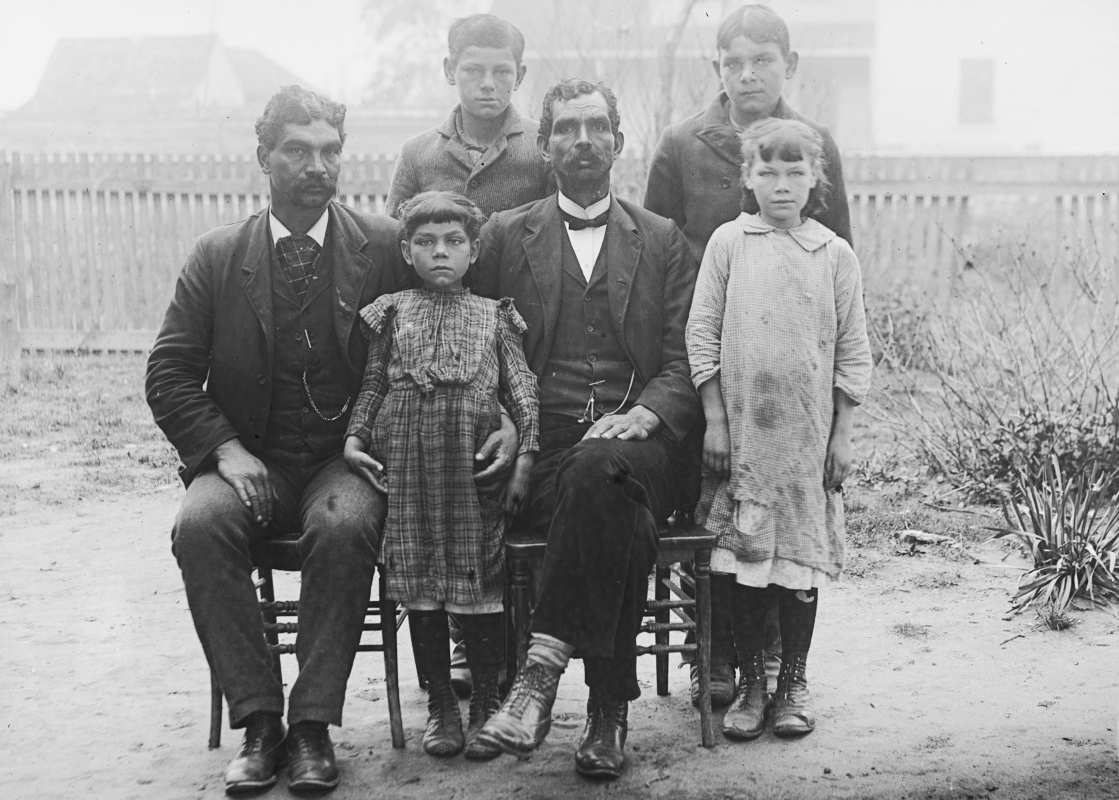
Frank Speck (November 8, 1881 – February 6, 1950)
Frank Speck graduated from Columbia University with a B.A. in anthropological ethnography in 1904. He went on to earn an M.A. and Ph.D. in the same research area and became a professor at the University of Pennsylvania. At a time when many anthropologists were interested in studying foreign cultures, Speck was dedicated to the study of Eastern Woodland Native Americans. As part of his research he visited many of the Algonquian Indian remnants of Virginia in the 1920s and actively advocated for their political recognition. In 1928 he published “Chapters on Ethnology of the Powhatan Tribes of Virginia, Indian Notes and Monographs” which included notes on the Nansemond people.
The importance of Mooney and Speck’s research to Virginia Indians cannot be understated because it was conducted around the same time as the passing of the Racial Integrity Act when many members of state government were trying to erase evidence of Indian communities in Virginia. They gave validity to people who were thoroughly assimilated yet maintained an Indian identity (validity that is still relied upon today as the sole research references in the Thomasina E. Jordan Indian Tribes of Virginia Federal Recognition Act of 2017).
Despite the value of Mooney and Speck’s research, they have also been criticized due to their emphasis on racial purity as a means of “salvaging” Indian populations. Arica Coleman’s book “That the Blood Stay Pure, African Americans, Native Americans, and the Predicament of Race and Identity in Virginia,” provides a detailed analysis of the sociopolitical dynamics that formed the relationships between prominent anthropologists and Virginia Indians. Coleman’s research reveals that many conflicts related to race originated with the intentions of anthropologists rather than with Virginia Indians.
Albert Dehner Bell
Albert Bell was a genealogist who published research on a number of families from 1947 to 1997. He was commissioned by Edward Bass to compile a Bass genealogy (including oral history from Bass family members) which was published in 1961. Bell’s book, titled “Bass families of the South : a collection of historical and genealogical source materials from public and private records” was the preeminent Bass family reference for many years. In more recent years, some have criticized his research (citing errors and a bias toward proving the Basses had Huguenot ancestry) but others have noted that his book is fundamentally a compilation of information from other resources and can be trusted (for the most part) as a reference.
Helen Clark Rountree
- B.A. in Sociology & Anthropology, College of William and Mary
- M.A. in Anthropology, University of Utah
- Ph.D. in Anthropology, University of Wisconsin-Milwaukee
- Professor of Anthropology, Old Dominion University
Helen Rountree is the longest active and most published researcher of Virginia Indians. She began her research in 1969 and, over the course of her career, closely studied numerous tribes from historical, anthropological, cultural, and political perspectives. Rountree was openly critical of some of Mooney and Speck’s methodology (suggesting that they influenced tidewater Indians to conform to their preconceived notions of “Indianness” rather than objectively observing them as they were); however, she continued their legacy of anthropological advocacy to support Virginia Indian tribes during their petitions for state recognition in the 1980s.
Some of Rountree’s most popular publications are The Indians of Virginia: A Third Race in a Biracial State (1979), Ethnicity Among the Citizen Indians of Tidewater Virginia (1986), and Pocahontas’s People: The Powhatan Indians of Virginia through Four Centuries (1990). While each of her publications sheds light on Nansemond people, her paper “The Ethnogenesis of a Virginia Indian Tribe: The Nansemond Indian Tribal Association” contains the most detailed and intimate account of recent Nansemond history.
Danielle Moretti-Langholtz
- Ph.D. in Anthropology, University of Oklahoma
- Professor of Anthropology, College of William & Mary
- Researcher with the Werowocomoco Research Project
While Helen Rountree is the most recognizable name in Virginia Indian research, Danielle Moretti-Langholtz should be of interest to Nansemond researchers. She completed a thesis titled “Other Names I Have Been Called: Political Resurgence Among Virginia Indians in the Twentieth Century” which included an in-depth account of two years of fieldwork in the late 1990s with the Nansemond tribe. Moretti-Langholtz was able to observe private historical records and interview tribal members on a number of different issues. Some of her research reiterates Rountree’s findings but it is also demonstrative of the next stage of social and political evolution for Virginia Indians. Moretti-Langholtz’s research is publicly available and is a source of information on Nansemond tribal dynamics that is not shared in other locations.
In Summary
- The Nansemond Indian Tribal Association (NITA) is a relatively young and growing organization (it is not an uninterrupted continuation of a historical power structure). Leadership has evolved over the years and advancements have been based on personality types, education on tribal history and genealogy, and the overall sociopolitical climate.
- While historical perspectives of Nansemond people are generally undisputed, a number of people from inside and outside the tribe have influenced Nansemond genealogical perspectives. The interpretation of historical records and, more recently, genetic data has led to decades-long disagreements and the body of genealogical information continues to expand and undergo new evaluation.
- Many details which are not documented on Nansemond tribal website(s) are publicly available. The full history of the tribal association’s formation, early membership and meetings, establishment of by-laws and enrollment processes, and relationships with other tribes and local and state government are all documented in great detail by Virginia anthropologists.
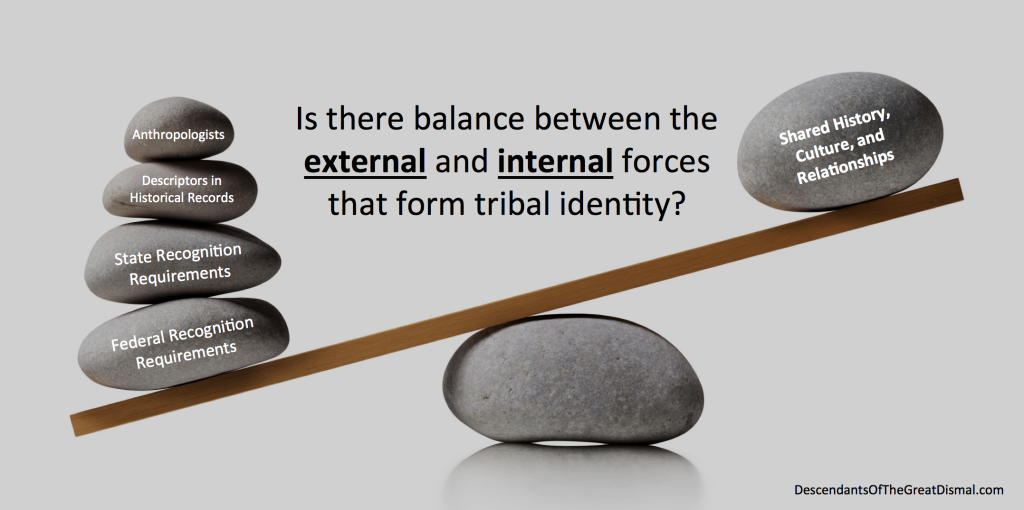
Part of my reason for writing this article is the perception that NITA information is “private” and that unenrolled Nansemond descendants cannot learn about the tribe. This perception is, for the most part, unfounded considering the candid information about the recent history of the tribe that is available in a variety of resources. It is true that there are a number of genealogical issues to be resolved that significantly affect eligibility for tribal enrollment but these issues originate from a number of sources—not solely from the tribe (i.e., inconsistencies in historical records, misguided anthropological advocacy, requirements for state and federal recognition, etc.). Decades of disagreement can be intimidating to new researchers but, after (somewhat) exhaustive research, I have seen nothing to suggest that these issues are insurmountable.
Category: Blog, Genealogy, Native Americans, Race & Ethnicity Tags: Augustus A. Bass, Barry Bass, Earl Lawrence Bass, Ethnogenesis, Federal Recognition, Frank Speck, Gallberry Road, Great Dismal Swamp, Indiana Church, James Michael Bass, James Mooney, Jesse Lindsay Bass, Lake Drummond, Mattanock Town, Nansemond, Nansemond Indian Tribal Association, NITA, Oliver Linwood Perry, Powhatan, Racial Integrity Act, State Recognition, Virginia Indians, Walter Plecker, Washington Ditch, Yadkin
52 Comments on “The History of the Nansemond Indian Tribal Association”
Leave a comment Cancel reply
Descendants of the Great Dismal
You should read ” John Bass of Virginia” Documents Relating to the Lineage and Family of John Bass 1673-1732 by J Albert Bass Jr. He goes into depth to explain why Dowd and Silvestri are wrong in their claim that John and his brother Edward are not sons of William 1654. It’s filled with records of deeds and information on how counties changed over time and he goes into detail to explain why Dowd and Silvestri were wrong in their claim and that John1673 and Edward1672 are sons of William1654.
LikeLike
Gene, to be clear, this article is not a defense of Lea Dowd’s positions (or anyone else’s for that matter). She is included here based on her historical role within the Nansemond Indian Tribal Association. If you click the links in the Dowd section you will see that Lars Adams’ dispute of her findings was included.
LikeLike
I have only just learned that Lea Dowd died July 20, 1917 at a hospice in Columbus, Georgia. Her obituary is: https://www.legacy.com/obituaries/Ledger-Enquirer/obituary.aspx?pid=186181743
LikeLike
How do I become an enrolled Member of the Nansemond Tribe that i am…I have Turned in an Application for my father which is a documented full blood Nansemond by Both parents when I Write and call to the Nansemond tribe and do not get an answer. I talk to the chief and cant get him on the phone after he answers once to see who it is calling…..No one will tell me any information…..Can someone please tell me when enrollment is to start again……How many Applications have you kept the checks for? How Many Applicants do you have? So, Cousins of the Nansemond Tribe I would like to offer my Professional Assistance in Vetting those few Applications for you.
LikeLike
Hello, Many tribes are skeptical today when people make claims. There have been so many false or unproven claims that people do not trust. Tribes have to split funding. Think of it as another child born to a family. It is best to gather your proof and see someone in person.
LikeLike
Dear Gene,
Thank you for your comment. Can you tell us where to find access to read your recommendation: “John Bass of Virginia” Documents Relating to the Lineage and Family of John Bass 1673-1732 by J Albert Bass Jr.? I am a descendant of John-1673 via my Calhoun/Cohoon-Futrell-Bittle-Bass line. I am striving to document my ancestral lines to find the truths of my lineages, including this one, so I’m not erroneously “barking up the wrong tree” or “climbing someone else’s family tree”.
Many Thanks,
Rose
LikeLike
Would love to know this also, I am a direct Bass Decendant, straight Bass all the way through.
LikeLike
I sent a reply that isn’t showing up yet. Hope it didn’t disappear into cyberspace.
LikeLike
Cyberspace! John, William, John John, Jacob,Theopolis, John, Stephen, Gilbert, Jesse, Jesse, Me!
LikeLike
Got it! Sent from my Galaxy Tab® A
LikeLike
I don’t think it’s in circulation. However I know there is a copy in the Public library in Wilson, North Carolina. I got my copy from the author who is a cousin.
LikeLiked by 1 person
Thank you! My Dad Jessie Leslie Bass Jr. Was raised in Southern Pines. But never revealed much history. I’m in Idaho where he resided since early 50’s. I will have to see what I can find. Is there anything on William, John 1616 son? I trace through him. But, Elizabeth’s mother, and Williams father are a mystery!
Thank you for your time! Robin. The middle aged Bass!
LikeLike
Gene, this is where the post started. Referring us to the John Bass of Virginia book on filed at I don’t remember which library!
Now I’m having issues with Stephen Bass son of John Edward Bass. I dont believe his wife was Polly due to the Dorris Harris Papers on Green Family. And those listing who Polley married.
LikeLike
Hi Rose, I am a member of that Futrell family also and trying to find info.
LikeLike
It’s me again. I have made numerous attempts to post a two-part reply but nothing has worked. Robin can you send me a copy of what you received since my original was lost to me in cyberspace?
LikeLiked by 1 person
I understand, didn’t mean to imply that, just thought you might be interested in some good research material.
Enjoyed the article!
LikeLiked by 1 person
What a great historical write up! Thanks for sharing. Loved learning about each person’s contributions, even the researchers!
Awesome read.
LikeLiked by 1 person
“The integration of genetic data (and the patrilineal Y-DNA of Bass descendants) into the establishment of Nansemond lineage has been a recent source of contention among descendants and researchers.”
I would be interested in learning more about these genetic data and Y-DNA issues. Why have they been a source of contention?
LikeLike
The Bass FamilyTreeDNA site is a good starting point. This is not an endorsement of any statements on this site—merely an introduction to some of the sources of contention.
LikeLike
I am Carrie ” Bass ” Needler
I believe we may be related.
Grandfather is William Henry Bass of McRae, Arkansas.
LikeLike
Carrie, Not sure exactly which William or if there is a William he would be before Jenkins Bass(1802-1865) who we can’t verify his father. Appears he’s involved with the West family but that is hard to prove as there were several court house fires in Sampson county NC that destroyed many land, birth, and marriage records. Will need to continue searching and maybe someday somebody will come on here with concrete info like a family bible or photos or letters or deeds or some record that connects. Thanks for hitting me up. If you have evidence please advise
LikeLike
I am supposed to have a direct lineage from some one named Dickie Bass through some gettus bloodline.If anyone can give me some insight or maybe sounds familiar to some one,or has info about a path to undergo or recognizes something about this ,I live in ca.on the Yurok Indian Reservation ,am married to a Yurok man of 21 years, and have Five children four girls and one son of Yurok descent,and am trying to establish the possible connection to the other side of our heritage and
If I can define my search, and it be of true descent ,my family can partake in other types of dancing thus therfore celebrate and participate on both sides of the bloodlines and contribute to both sides our wonderful traditional abilities we love to demonstrate and share with people in our family we have never yet known.thankyou for consideration and or directive.,
R.S.(Dougan)Nelson.
LikeLike
I love how informative and insightful your website is Nikki! I am a descendant of the John Bass Sr./Love Harris line and I’m just now reading up on the Y-DNA information via the other site you recommended. I’m still a bit confused though (my brain cells are pretty fried today LOL!) You seem to be able to understand it all much better than I do…can I ask you a question? I’m just trying to figure out if my line is related to the main Bass family through the DNA in the study? I read this post, the one at the very top of the page at this website:
https://wc.rootsweb.com/cgi-bin/igm.cgi?op=GET&db=llclements-clem&id=I2254
but I can’t quite figure out if this means that my line (the John Bass/Love Harris line) is genetically related to the main Bass family – the one descended from another man named John and woman named Elizabeth who was Nansemond Indian – or not based on the Y-DNA study.
Does any of the Y-DNA in the study show a link between my line and theirs? I’m guessing there’s no fatherly link but perhaps a cousin link through Richard Bass? I don’t quite understand it.
Thanks in advance if you can help me figure it out, I just am not sure which line I am related to and my brain cells are pretty frozen today LOL 🙂
LikeLike
I am also a descendant of that lineage.Just recently starting doing my families genealogy.I would be grateful for any info.My great great grandmother was Kate Ellen Bass.We live in SW Louisiana.Thanks!
LikeLike
Me too!
Descendants of John Bass
1 John Bass b: Dec 4, 1673 in Norfolk Co, VA d: Jan 18, 1731/32 in Bertie Co, NC
.. +Love Harris b: 1676 d: Abt. 1707
. 2 Edward Bass b: 1698 in Bertie Precinct, NC d: Bef. 1786 in Dobbs Co NC
….. 3 Wright Bass b: Abt. 1722 d: in Georgetown SC
….. 3 Arthur Bass b: Abt. 1726 d: 1820
……… +Mourning Richardson
….. 3 Jeremiah Bass b: Abt. 1730 in Dobbs Co NC d: Aft. 1820 in Wayne Co NC <– my family
I'm from Esau Bass Mississippi family line. Does anyone know if Jeremiah was authenticated? I've found lots of sites that say he's the son of Edward, but no "hard facts"
LikeLike
My great great grandmother was Minnie Bass Simmons b:1871 in Sampson County NC.Does anyone know anything about her family?She married Marshall Simmons and is buried at Brown Baptist church cemetery in Clint9n,Sampson County NC. Thanks for all your hard work on our family. God Bless You
Yours truly,
Jennifer Hughes -Martin
LikeLike
Barry Big Buck Bass was actually the son of Joseph Alwood Bass, the son of Earl Lawrence Bass.
LikeLike
I have been working on my family history and I have tracked back my grandmother’s side to about 4 generations. Her maiden name was Coppage. She always said that we had Indian blood in us and her great grandfather (I don’t know how many greats) was an Indian Chief and his daughter was an Indian princess and she married a fur trapper. Closest I can find so far was it must have been from the John Basse that married Elizabeth. When we would ask about what tribe she would only say “the mean ones”…..which I understand the Nansemond were very aggressive at the beginning when the English treated them so terrible. I tracked the Coppage line from my grandmother Artie Coppage born 1892 in the Fordsville Kentucky area, then her father James Franklin, his father Tandy and the Alexander Coppage (who was hung from a mulberry tree during the civil war (which she had told us that story too which was backed up by reports. I just wonder where did the first Coppage marry into the Basse family. Any info would be greatly appreciated. That you, Susan. Email Valpakskh@aol.com
LikeLike
I have noticed you don’t monetize descendantsofthegreatdismal.com, don’t waste your
traffic, you can earn additional bucks every month with new monetization method.
This is the best adsense alternative for any type of website (they approve all websites), for more info simply search in gooogle:
murgrabia’s tools
LikeLike
Great read thank you for posting . It’s always nice to read the stories of the elders of the tribe. The ones that pave the way! The research is interesting. I’m originally from South West Louisiana . My grandmother was Pearl Bass. She was married to William Stanley. They both lived on Bear Head Creek in Starks, Louisiana. I descend from William 1654 about five or six times in my family tree. On my mother side my grandmother‘s Maiden name was Perkins. I can honestly say one thing . Figuring out a tree of Natives is not easy by any means. The native blood is still running strong in us. As I started reading the article I noticed a Bass & Perkins couple. It made me smile! Thank you for posting! I hope to hear more as time goes on. Thank you and God bless!
LikeLike
Hello, I like your post. Virginia made laws to separate people for more than two centuries. Do you know how far back records are for the Nansemond and the surnames?
LikeLike
Dear Nikki,
I am Ken Molzahn and my wife, Sue, and I began a patriotic flag display of the American Revolution beginning in 2017 with 26 flags and it’s grown to over 300 replica flags for our 2020 Flagway. Our project is, obviously enough, The American Revolutionary War-Era Flagway, The 200 16 foot flagpoles line our 1/8th mile driveway. I know in the very recent past the VA Sons of the American Revolution honored your tribe with your own chapter to recognize the service of your warriors in the Our Revolution. Sue and I have nearly all the American flags(regt, militia, dragoon, naval ensigns and 13-star US flag variations), All the French flags, All the Spanish Flags, All the Captured, Surrendered or Defeated British Regt of Foot, Hessian and known Loyalist Flags AND the flags of Native American Tribes REPRESENTING their alliance and sufferings fighting shoulder to shoulder with Patriot units (e.g., Oneida at Oriskany or the Stockbridge at Benington). SO herein is my question: Do you know, for example if your warriors fought at the Battle of Great Bridge? OR In general what exact battle(s) your tribe fought in. We simple wish to honor your tribe by placing your tribes flag on the flagpole most appropriate to honor their assistance in OUR FOUNDING STRUGGLE against the BRITISH!
WE live in Collins, Missouri and will gladly send you a picture of your tribes flag flying in the 2020 Flagway later this spring when it up AND upon receiving the request historical information to place it with honor!
Sincerely
Ken and Sue Molzahn
Collins MO USA
molzahngb@gmail.com
LikeLike
I am Anthony Bass in NC with Sampson county origin….Tough to follow family line going backward from George Washington Bass..his father Edwin Bass 1828 who died in 1865 from Civil war wounds along with three sons brothers of George W. and then Jenkins Bass 1802 who appears under another family name although his father is Andrew Jackson Bass Sr. 1759, then Richard Washington Bass Jr. 1707-1780, then Richard Basse Bass Sr 1658-1722 son of Rev. John Bass 1616-1699 and Elizabeth Basse 1624-1676
LikeLike
Going back ward,
I am Robin Leslie Bass..
Father Jesse Leslie Bass Jr,
GF Jessie Leslie Bass,
GGF Gilbert Franklin Bass,
GGGF, John William Bass,
GGGGF, Stephen Bass
GGGGGF John Edward Bass.
GGGGGGF TheopolIs Bass,
GGGGGGGF Jacob Oren Bass,
GGGGGGGGFJohn Bass to Elizabeth W. ,
GGGGGGGGGF John Bass to Love Harris,
GGGGGGGGGGF William Bass to Catherine Lanier,
GGGGGGGGGGGF John Basse to Elizabeth the Nansemond,
Daughter of Robin the Elder Chief of the Nansemond,
Then to, Nathaniel Bass and Humphrey Humphrey Bass.
what documentation do you need to Follow this. I. Do have it from myself to Stephen Bass
Thank You, Robin Bass Van Leer
LikeLike
Cousin, My name is Frank Bishop, our lineage comes down through the Tilghman Family of Christopher Tilghman and Ruth Devonshire(Blount). Their son Gideon Sr. married Margaret Mannocks/Manax/Maneux… She was the daughter of Hugh Mannocks who had married the daughter of Malcom Thomas and Elizabeth ?. Malcom and his wife were murdered by their servant. The wife of Malcom (Elizabeth appears to be the daughter of ‘Robin the Elder’. These two families, Tilghman’s and John Robins AKA Robin the Elder, lived as neighbors. Gideon purchased land from John Robins at Pocomoke. This was at a time period when the Bacon Rebellion was building. The Powhatan Tribe was in conflict and not all supported the rebellion. Pamunkey and Mattaponi were at odds during this conflict…This all would make us a distant direct descendant of the Powhatan Tribe. Some indicate that Robin the Elder was actually Pamunkey and had been well educated and was seeing the need to assimilate in some way with the colonists…Ruth Devonshire has a long lineage with English royalty whose families had started the London Co. and the Jamestown venture. Ruth’s Gr Gr Grandmother was Mary Boleyn, stepsister to Elizabeth the 1st…Any comments welcome, and does this make sense…Any further info would be welcomed. Thx. Frank.
LikeLiked by 1 person
I haven’t heard of a direct documented source from Robin the Elder (John Robin) to Elizabeth.. I need to reread and contemplate! Thank you for your responce. I am not seeking membership, just knowledge! Has there been any research regarding Williams true father?
Thank you again, Robin Bass Van Leer.
LikeLike
I follow a straight Male decendancy linage to John Basse, Basses Choice was his plantation. William, (John 1616s son) was not his son, by DNA, but of a 1/2 Nansemond, 1/2 Sub Saharan ancestry, Parental or other children, except William Bass, have been documented to his DNA. Elizabeth as stated in the John Bass Bible being his mother. John did not adopt William, (but as the Matruchial of the family made the decisions including those in relationships, ) John 1616 raised William as his own, giving him his name.
There has been no proven lineage from Elizabeth directly to Robin the Elder, as the Weroances would take several wives, so even knowledge of her mother is not known. That is the key issue to Elizabeth.
I did read about a John Robins and followed him through some. Robin the Elders sister has be stated a Joan Tucker. Peter the Great, Nanseumind….Robin has also been AKAed as Robin Tuck, Robin the Elder, Elder Robin Tucker….but I have never heard of John Robins as a name for him.
Now there may have been more than one Elizabeth. But it has been Established in John Bass Bible that John 1616 was Wed to Elizabeth the Nansemond.
Now, are you as confused. As I am!
LikeLike
Anthony Bass…..Sorry for not making clear the issue…. Jenkins Bass, born 1802 is shown under a man named Willis West as his son..also shows his mother as Silvey Harmon, then Mary Cathrine Dudley, and another Laney Williams.. Problem Willis West’s wife died in 1799 given birth to a son..Jenkins was born in 1802 so not sure who his father was although it says Andrew Jackson Bass Sr.(1759) who moved to Alabama.. So how is Jenkins Bass shown a son of Willis West? Still not sure who his mother was
LikeLike
Pingback: Virginia’s First People | 1st U.S. Colored Cavalry
My mother was Myrtle A Goins Married to Lester Marze, I’m kin to the bass family, Essie Bass was my great Aunt. I love this heritage. My Grand mother was Daisey Goins, but she was a Lawrence.
LikeLike
I am a Bass, with straight grandfather heritage to William. No dievations through other lines! Jesse L Bass Jr, Jesse L Bass, Gilbert Green Bass. John William Bass, Stephen Bass, John Edward Bass, Theophilus Bass, Jacob Oren Bass, John Moses Bass,John Bass 1643, William “the Elder” Bass 1654, John Bass 1616..
12 Generations!
LikeLike
It has been proven through Bass DNA that William’s father was not John Basse but his mother was Elizabeth. William’s DNA is from the A Haplogroup M31 Cluster 3. John’s DNA and all subsequent ancestors of John’s are from the DNA R Haplogroup. William’s DNA is ancient and comes from Subsahara Africa. There are alot of documents showing William as a son of John Basse. He is not. He IS a son of Elizabeth. Check out the Bass DNA facebook page. Full of information, files and documents.
LikeLike
Hello cousin ! I’m a Lawrence. I have a book and my DNA. I have your line. All the way to William Bass 1654 the son of Elizabeth Bass the Nansmond. Your Grandmother Daisy Lawrence was the daughter of Eliza Jane Bass her husband was James Lawrence. Your grandmother Daisy’s mom and dad. Is my great grandparents bother and sister Margaret Elizabeth Bass is the sister of Eliza Jane Bass daughters of Jeriamiah M. bass b. 1838. M. Emeline Smith. Daisy’s father is James W. Lawrence. My great grandfather Mack David Lawrence’s brother. Both son’s of F. L. Lawrence died 1907 the surname Lawrence is also sometimes spelled Laurence. Eliza Bass she married first James Lawrence and had four children and after his death married James Tippit. I have information and our Linage on the Lawrence’s and Bass’s even pictures and description of your of Eliza Jane Bass and James and Daisy. Our families were all close back the day in Louisiana. They all lived in Vernon Louisiana and mine in Leesville LA. I done my DNA on 23&me. And on gedmatch. You should go on FB and join the Nansmonde Native Indian research site. Would love to get with you and share our linage information. I found one Gary Lawrence on 23&me. Our DNA is real close. Have a book full of info on Lawrence and the Tippit family.
LikeLike
Pingback: Ethnogenesis in the Great Dismal: The Trummell Family | Descendants of the Great Dismal
Job Bass circa 1740-1836 and Elizabeth (Bass) Rawls 1762-1840+-
LikeLike
Fascinating to find the Bass and Anderson family intermingled with the Pettiford and Weaver family! While I wouldn’t consider myself Nansemond as I am not really connected to the tribe, it is still very eye-opening to discover these things while tracing one’s genealogy. I appreciate the chance to learn more about them and their history. 🙂
LikeLike
I am a direct descendant of William Basse The African, William Bass 1654, John Bass 1673, Aaron Bass 1710, Edward 1760, Edward Thomas 1798, Jesse Franklin Bass 1820, Steven Doughas 1861, Julia Evelyn 1883, Orval Jordan, Maxine Jordan. If I run my DNA, will it provide anything worthwhile?
LikeLike
Pingback: mythologies of the Nansemond tribe – World Mythology
Pingback: MYTHOLOGIES OF THE NANSEMOND TRIBE – Indigenous Peoples Literature
It has been proven through Bass DNA that William’s father was not John Basse but his mother was Elizabeth. William’s DNA is from the A Haplogroup M31 Cluster 3. John’s DNA and all subsequent ancestors of John’s are from the DNA R Haplogroup. William’s DNA is ancient and comes from Subsahara Africa. There are alot of documents showing William as a son of John Basse. He is not. He IS a son of Elizabeth.
LikeLike
Sue,
Humphrey Basse, the grandfather of John Basse (1616-1699), had at least one sibling who lived in Yorkshire, England. This brother of Humphrey Basse was named Richard Basse (1569-1616).
After reading about white men with the A M-31 y-dna haplogroup who are alive today and living in Yorkshire (with ancestors there for centuries), it occurred to me that Nathaniel Basse, his son John Basse and John’s son William Basse (b. 1654) could actually have been African-descended. According to the FTDNA Basse group, there are men living today in the UK with the surname Bass who have the sub-Saharan Haplogroup A M-31. I’m not sure if these men self-identify but they could be white Basses with this rare A Haplogroup that other whites like the Revis family in Yorkshire (and Revis people who can to colonial Virginia in the early 1600s).
The thought of the Englishman John Basse (Elizabeth the Nansamond’s husband) having ancient Black DNA may make some people uncomfortable but it could, in fact, be the truth. As Basse/Bass descendants, I think we all have to keep our minds open and embrace the identities of all of the ancestors from whom we descend.
Please take a moment to read this old post from Basse researcher, Marcia McClure:
Re: The Rare English Black Bass Indians?
By Marcia McClure February 01, 2010 at 09:10:01
In reply to: Re: The Black Bass Indians
Gerry W. Bass 1/26/10
After reading all of the interesting posts, I decided to do some googling.Interpretations of DNA results sometimes changes at breakneck speed.The more people tested, the more interesting it becomes.
I can see from what you all have written that everyone has been looking at the wealth of early Colonial information available and scratching their heads as the haplogroup A result is a quandary.One of your DNA participants even has an A1a result – which all probably have if re-evaluated with enough markers tested.
Researchers have found some remarkable results in Yorkshire, England:
“In 2007, seven men from Yorkshire, England sharing a distinctive surname were identified as being from the A1 subgroup of haplogroup A. It was discovered that these men had a common male-line ancestor from the 18th century, but no previous information about African ancestry was known. The A-P108 subgroup is extremely rare. In addition to the seven Yorkshire men, only 25 living carriers of the A1-P108 subgroup are known, all of West African ancestry.”
http://en.wikipedia.org/wiki/Haplogroup_A_(Y-DNAhttp://en.wikipedia.org/wiki/Haplogroup_A_(Y-DNA)
There are a number of postings on this Yorkshire group.
What this says to me is that rather than looking for a sub-Saharan ancestor in the Colonies or descendants of the Lost Colony, it is more likely that this ancestor came to England with the Romans.The proof or disproof would come with a sampling of likely Bass men from England.Obviously easier said than done!
Since this Yorkshire group has attracted so much attention, I’m a bit surprised that the Bass results haven’t caught some geneticist’s attention.
Again, I think this hypothesis, posited by Marcia McClure and others, is totally possible. To read multiple posts, here’s the link–
https://www.genealogy.com/forum/surnames/topics/bass/5660/
Just some food for thought….
LikeLike
It was in the late 50’s when I was friends with Robert Lawrence Bass (Bobby). I visited his home (farm) on Yadkin Rd. in Deep Creek. Do you have knowledge if he is still alive? The family was kind and hospitable. I am reflecting on my life as I turn 79 and remember him as my first boyfriend. Thank you.
LikeLike